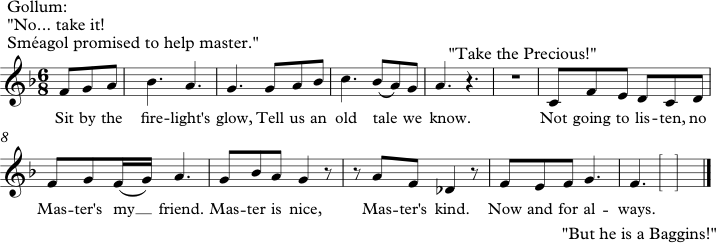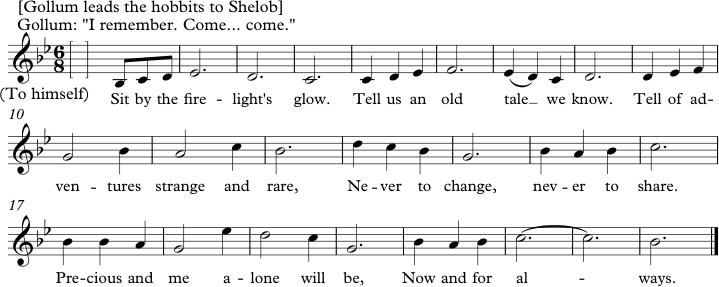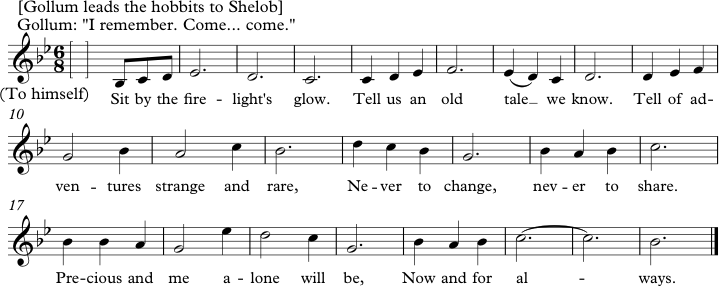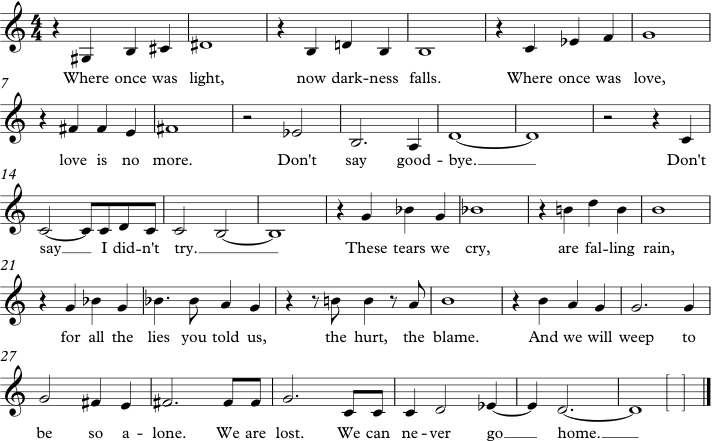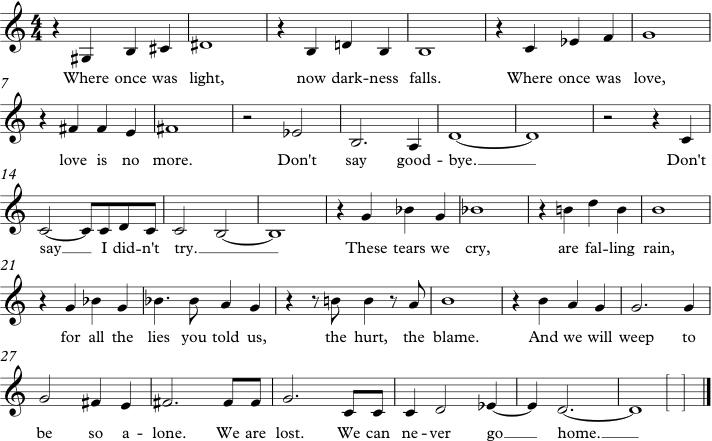The Lord of the Rings Musical, Smeagol, LotR M, Track 13, 4:10.
Howard Shore, “Long Ways To Go Yet”, LotR TTT CD 3, Track 14, 8:06, from 1:14.
Howard Shore, “Long Ways To Go Yet”, LotR TTT CD 3, Track 14, 8:06, from 1:14.
We have already discussed Gollum’s love of riddles as well as his view of the world on the basis of the Tolkien Ensemble’s version of Gollum’s Song from the book. Gollum is an evil creature with a very malicious agenda, but one at the same time cannot help but to pity him. Tolkien furthers both these aspects of Gollum by having his original self as Sméagol resurfacing several times in the story, leading to heated battles between Sméagol and Gollum. Furthermore, Gollum has completely stopped referring to himself as a single person, he speaks of himself as “we”. It appears that only after Frodo’s mention of his real name he began to remember his former self and to doubt the moral validity of his plan to kill Frodo and Sam. We can therefore assume that “we” refers to him and the ring, which he truly sees as a part of himself. This is backed up by his behaviour when finally reunited with the ring at the Cracks of Doom:
”’Precious, precious, precious!’ Gollum cried. “My Precious! O my Precious!" Ands with that, even as his eyes were lifted up to gloat on his prize, he stepped too far, toppled, wavered for a moment on the brink, and then with a shriek he fell. Out of the depths came his last wail Precious, and he was gone.
LotR, 946
The only time when Gollum ever refers to himself as “I” is when he is talking about the Ring. So when he wins his “prize” back, he is as happy as a wretched creature like him could possibly be. His behaviour - most notably his plan to kill the Hobbits by means of Shelob even though his true self (Sméagol) is aware of the evilness of the plan and tries to stop him from executing it – suggests that he is completely controlled by the Ring. The “we” would then refer to Gollum driven by the Ring, not to his true self, which seems to have lain completely dormant until Frodo reawakened it by saying Sméagol’s name.
Schizophrenic characters and their actions and interactions with their “other side” are a classical device not only in literature, but also in all visual arts extending to music theatre. As such it is not surprising that The Lord of the Rings stage production stresses this aspect of Gollum’s personality and makes it the driving force of the character. Gollum has his own song, aptly titled Smeagol18, which immediately follows Frodo’s and Sam’s duet Now and for Always. After Frodo sings his verse about Sam, he falls asleep during the chorus and Gollum finishes the song. After a brief interlude, he continues to sing:
transcription (beginning): Smeagol, LotR M, Track 13, from 0:26.
Sméagol repeats the central line from the Hobbits’ song, but is interrupted by his Gollum personality urging him to take the chance and try to get rid of the Hobbits (0:33). The two personalities are clearly discernible and we can see Sméagol’s struggle – he does not want to hurt Frodo, but ultimately looses against Gollum. The two argue while the Hobbits are asleep. Gollum eventually wins by shouting down Sméagol and maintains that “we hate Bagginses”, because they (meaning Bilbo) stole his “precious” (0:52). There seems to be a bit of hope for Sméagol to gain the upper hand when he remarks that Frodo promised to free him if he led them to Mordor. This section has Gollum dancing to a musical underscore heavily drawing on Hobbit folk music, suggesting his past as a hobbit (1:51). But Gollum trashes his hopes and calls him a coward (2:50). Sméagol says that “we change” because his master is nice to him (2:58). Right at that moment Sam intervenes and accuses him of “sneaking”, allowing Gollum to resurface and lead the way on. Like in the book and film, Gollum then has an inspiration how to kill the Hobbits: “She” will help, meaning Shelob.
transcription (continued): Smeagol, LotR M, Track 13, from 3:28.
While clearly Sméagol sings the first repetition of the Hobbits’ chorus (he secretly wishes he could be part of them and probably remembers past times), after Sam’s intervention, his Gollum side has completely taken over. Gollum turns the meaning of “Never to change” completely around: While in the Hobbits’ song it stands for staying true to each other, for friendship and loyalty, Gollum interprets it as not deviating from his set goal to win back the Ring and not giving to reason and accept that Frodo could indeed be his friend. The line “never to share” confirms this decision to not trust anyone. Gollum’s mind had been poisoned by his “Precious” for too long. In Smeagol we encounter a tortured and broken creature tragically fighting and loosing a battle against his longing for the Ring. The use of both the melody of the Hobbit song, as well as the instrumentation, which evokes Sméagol’s origin as a Stoor hobbit, add to the tragedy of the creature. When Gollum falls into the Cracks of Doom at the end of the stage production, clutching the Ring in utter delight, his sad life comes to an end – presumably, for him, a good one even.
In the motion picture trilogy, during the End Credits each of the films has a song inserted before the final score suite19, which deals with a topic from that particular film. The songs from The Two Towers as well as The Return of the King we will look at in some detail. With Gollum playing such a big role in the second film (he is only briefly seen in the first film and only appears as a major character in The Two Towers), it comes as no surprise that he is the subject of this film’s song, sung by a female voice. Gollum’s Song draws the picture of Gollum as a sad being tortured and corrupted by the Ring, very similar to his portrayal in the stage show. Contrary to the musical, though, it is less the actions he is driven to by the Ring that the song focuses on, but rather his plain misery. Gollum is no evil creature, he is a victim.
So in the end,
I'll be, what I will be.
No loyal friend was ever there for me.
Now we say goodbye.
We say, you didn't try.
These tears you cried,
Have come too late.
I'll be, what I will be.
No loyal friend was ever there for me.
Now we say goodbye.
We say, you didn't try.
These tears you cried,
Have come too late.
Take back the lies,
The hurt, the blame.
And you will wait,
When you face the end alone.
You are lost.
You can never go home.
You are lost.
You can never go home.
The hurt, the blame.
And you will wait,
When you face the end alone.
You are lost.
You can never go home.
You are lost.
You can never go home.
transcription: “Long Ways To Go Yet”, LotR TTT CD 3, Track 14, from 1:14.
The song immediately follows the final scene of the movie with no separation from the actual score. It begins with Gollum being addressed in the second person plural. Presumably Gollum sings the song about himself and once again speaks of himself in this way. The second part of the song then switches to the first person singular (from 2:30). As Adams notes:
this [the song] marks an important turn for the character; it highlights the point at which Sméagol begins to adopt Gollum’s views.
Adams, 265
Indeed up to this point, the nice personality of Sméagol had been prevalent, with the final film being centred on his Gollum side.20 The song itself serves as a description of Gollum’s situation by directly referring to his past life as a hobbit. The “you” the text addresses in the line “for all the lies you told us” may be the Ring itself. Having alienated Sméagol from everything and everyone (even from himself!) and having made him a puppet of the will of his “Precious”, the Ring has made sure that “We [Sméagol] are lost”. From “We say, you didn’t try” on, the focus changes: No longer does Gollum refer to himself, but here we get an outside view of Gollum’s situation, accusing him of not trying hard enough to resist the Ring. “These tears you cried have come too late” – the Sméagol buried deep inside Gollum could have repented earlier. A harsh judgement, but one that ultimately shows the whole tragedy of Gollum.

